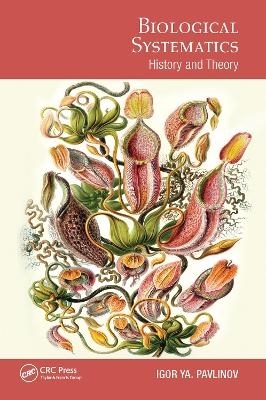
Biological Systematics
CRC Press (Verlag)
978-0-367-67194-5 (ISBN)
This volume reviews the historical roots and theoretical foundations of biological systematics in an approachable text. The author outlines the structure and main tasks of systematics. Conceptual history is characterized as a succession of scientific revolutions. The philosophical foundations of systematic research are briefly reviewed as well as the structure and content of taxonomic theories. Most important research programs in systematics are outlined. The book includes analysis of the principal problematic issues as "scientific puzzles" in systematics. This volume is intended for professional taxonomists, biologists of various specialties, students, as well as all those interested in the history and theory of biology and natural sciences.
Key Features
Considers the conceptual history of systematics as the framework of evolutionary epistemology
Builds a hierarchically organized quasi-axiomatic system of taxonomic theory
Contends that more reductionist taxonomic concepts are less objective
Supports taxonomic pluralism by non-classic philosophy of science as a normal condition of systematics
Documents that "taxonomic puzzles" result from conflict between monistic and pluralistic attitudes
Related Titles
de Queiroz, K. et al., eds. Phylonyms: A Companion to the PhyloCode (ISBN 978-1-1383-3293-5)
Sigwart, J. D. What Species Mean: A User's Guide to the Units of Biodiversity (ISBN 978-1-4987-9937-9)
Rieppel, O. Phylogenetic Systematics: Haeckel to Hennig (ISBN 978-1-4987-5488-0)
Wilkins, J. S. Species: The Evolution of the Idea, 2nd ed. (ISBN 978-1-1380-5574-2)
Igor Ya. Pavlinov is at the Zoological Museum of the Moscow Lomonosov State University in Moscow, Russia.
Table of contents
Preface
Introduction
Chapter 1. A brief outline of systematics
1.1. What is the Natural System
1.2. What is biological systematics
1.2.1. The structure of systematics
1.2.2. What does systematics study
1.2.3. How does systematics study
1.2.4. What does systematics study for
Chapter 2. Conceptual history of systematics
2.1. Some preliminary considerations
2.1.1. How conceptual history can be written
2.1.2. History of systematics as an evolutionary process
2.1.3. Major steps in the history of systematics
2.2. Prehistory of systematics
2.2.1. An initial step: Folk systematics
2.2.2. Becoming aware of The Method
2.2.3. The Herbal Epoch
2.3. The beginning of systematics: Scholastic revolution
2.3.1. Major features
2.3.2. Major stages
2.4. Emergence of biological systematics: Anti-scholastic revolution
2.4.1. Major non-scholastic motives
2.4.2. The natural systematics
2.4.3. The origin of typology
2.4.4. The "taxonomic esotericism"
2.5. A step forward: Evolutionary revolution
2.5.1. First ideas
2.5.2. First debates
2.6. A step aside: Positivist revolution
2.7. Homage to metaphysics: Post-positivist revolution
Chapter 3. Some philosophical considerations
3.1. Classical and non-classical science
3.2. Cognitive situation
3.2.1. Cognitive triangle
3.2.2. Conceptual space
3.2.3. Conceptual pyramid
3.3. Some cognitive regulators
3.3.1. Between Umgebung and Umwelts
3.3.2. Between holism and reductionism
3.3.3. Between realism and nominalism
3.3.4. Between monism and pluralism
3.4. Knowledge as an information model
3.5. The logical bases
3.6. Argumentation schemes
3.7. Methodologies and methods
3.7.1. Scientific status of methodologies and methods
3.7.2. Basic methods
Chapter 4. An outline of taxonomic theory
4.1. Taxonomic theory as a quasi-axiomatics
4.1.1. General and particular taxonomic theories
4.1.2. Basic quasi-axioms and principles
4.2. Defining basic notions: Two study cases
4.2.1. Taxonomic reality
4.2.2. Classification system
Chapter 5. Major research programs in systematics
5.1. The phenetic program
5.2. The rational systematics
5.2.1. The onto-rational program
5.2.2. The episto-rational program
5.3. The numerical program
5.3.1. Major features
5.3.2. Two basic versions
5.3.3. Basic controversies
5.4. The typological program
5.4.1. Major features
5.4.2. Contemporary developments
5.5. The biomorphic program
5.6. The biosystematic program
5.7. The phylogenetic program
5.7.1. Major features
5.7.2. Evolutionary taxonomy
5.7.3. Cladistic systematics
5.8. The evolutionary ontogenetic program?
Chapter 6. Taxonomic puzzles
6.1. Between natural and artificial classifications
6.2. Between taxon and character
6.3. Hierarchies: To rank or not to rank?
6.4. Between similarity and kinship
6.5. What is the (arche)type?
6.6. Homology, an unresolved problem
6.7. An undiscoverable essence of species?
References
| Erscheinungsdatum | 07.09.2022 |
|---|---|
| Reihe/Serie | Species and Systematics |
| Verlagsort | London |
| Sprache | englisch |
| Maße | 156 x 234 mm |
| Gewicht | 520 g |
| Themenwelt | Naturwissenschaften ► Biologie ► Botanik |
| Naturwissenschaften ► Biologie ► Zoologie | |
| ISBN-10 | 0-367-67194-8 / 0367671948 |
| ISBN-13 | 978-0-367-67194-5 / 9780367671945 |
| Zustand | Neuware |
| Informationen gemäß Produktsicherheitsverordnung (GPSR) | |
| Haben Sie eine Frage zum Produkt? |
aus dem Bereich


